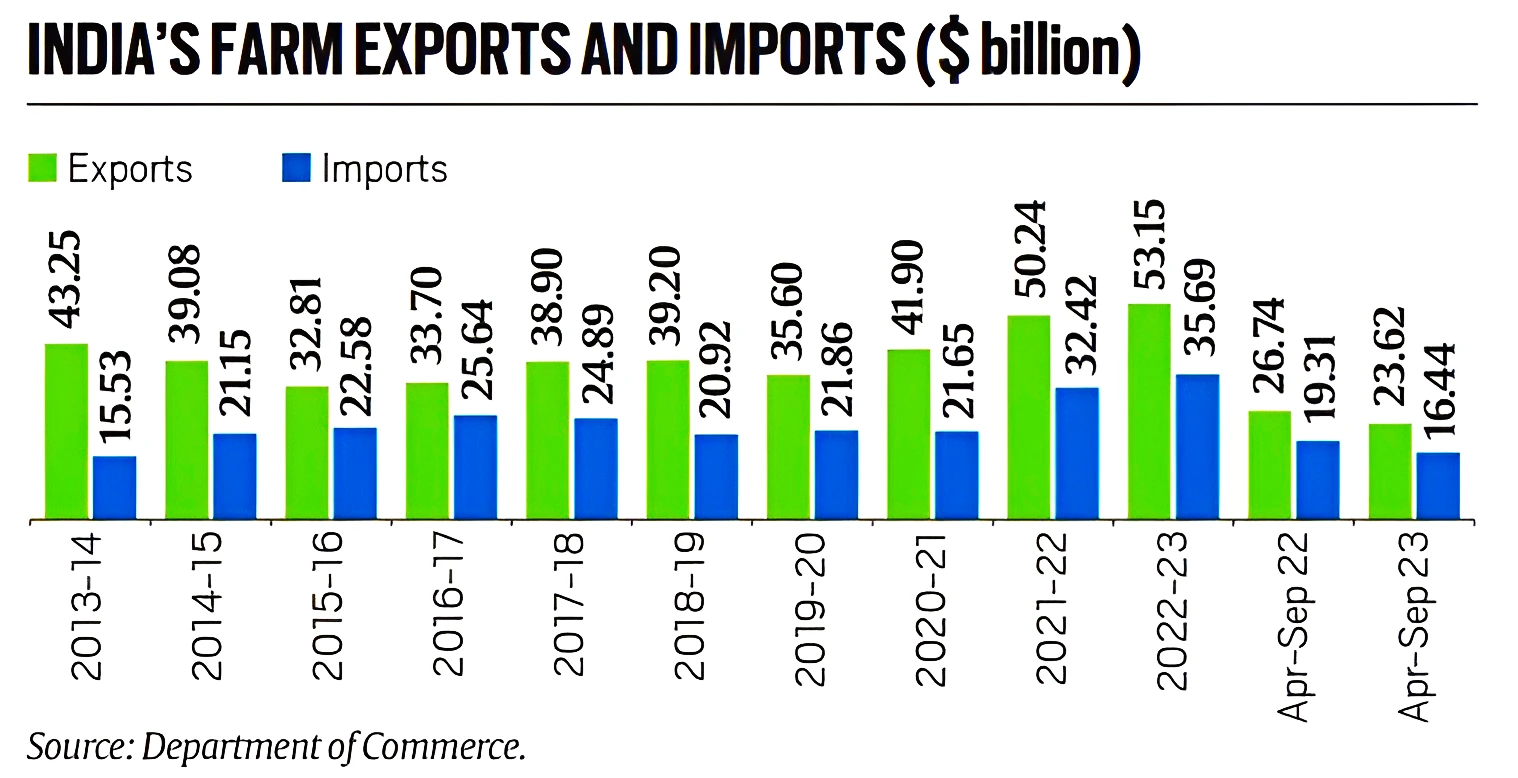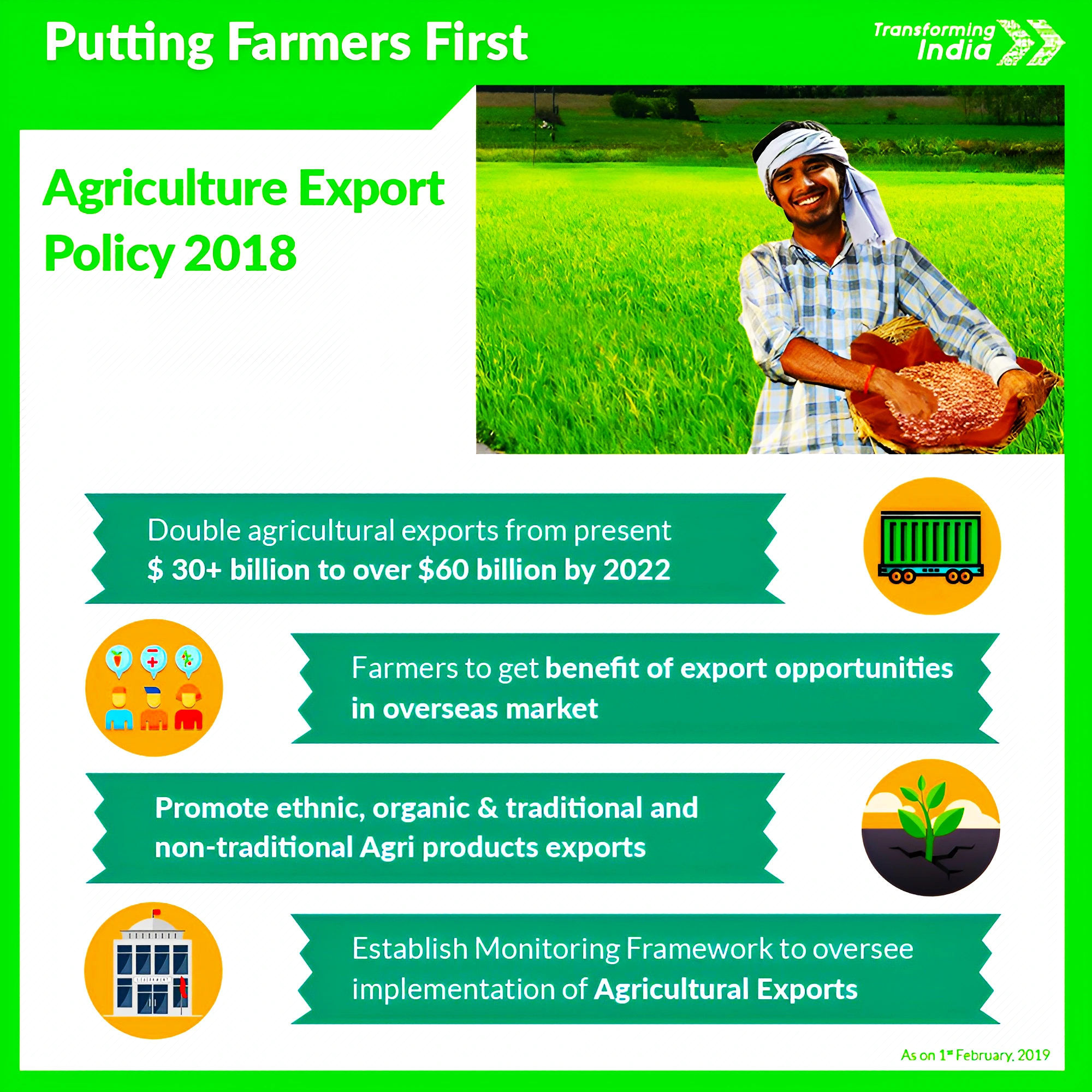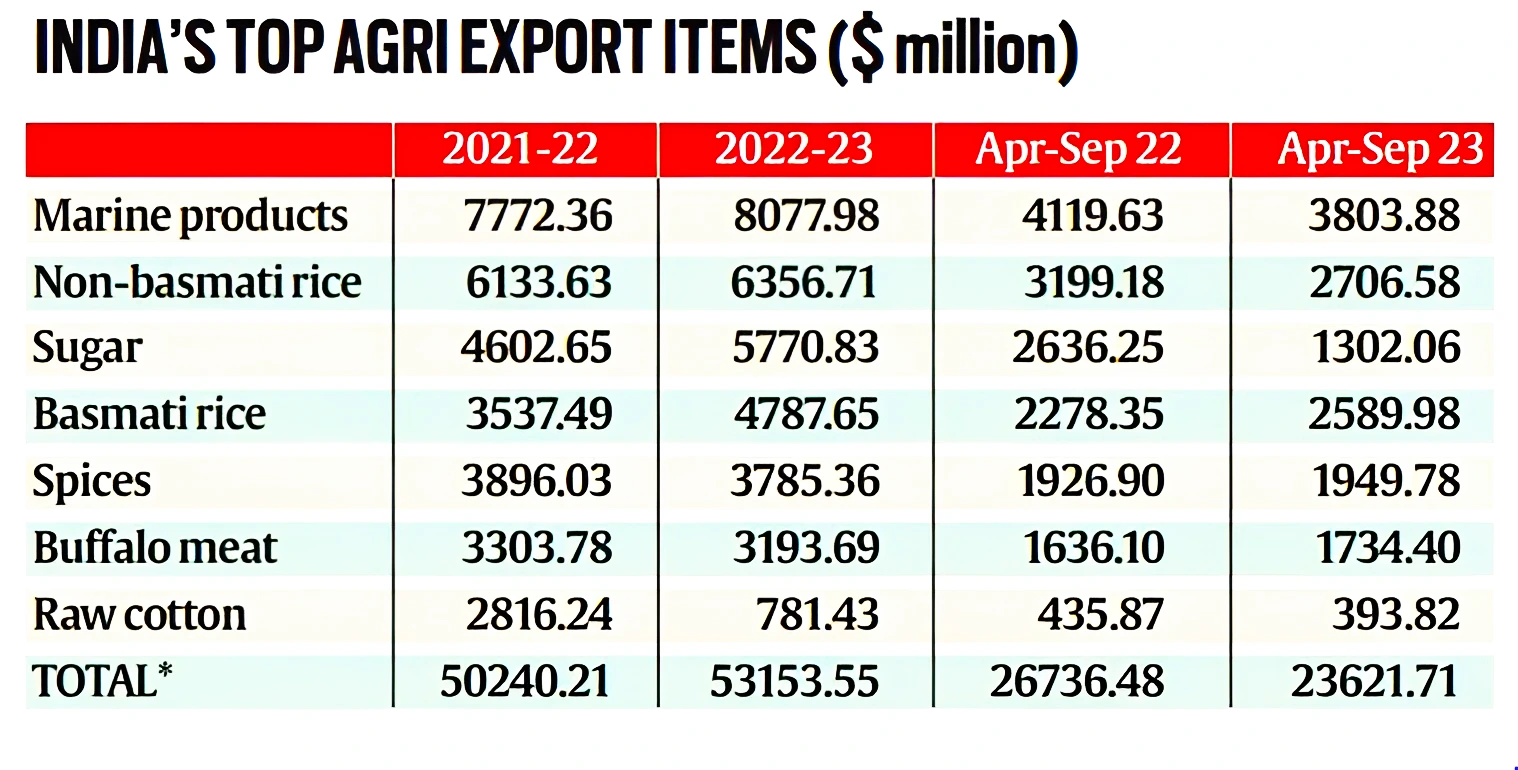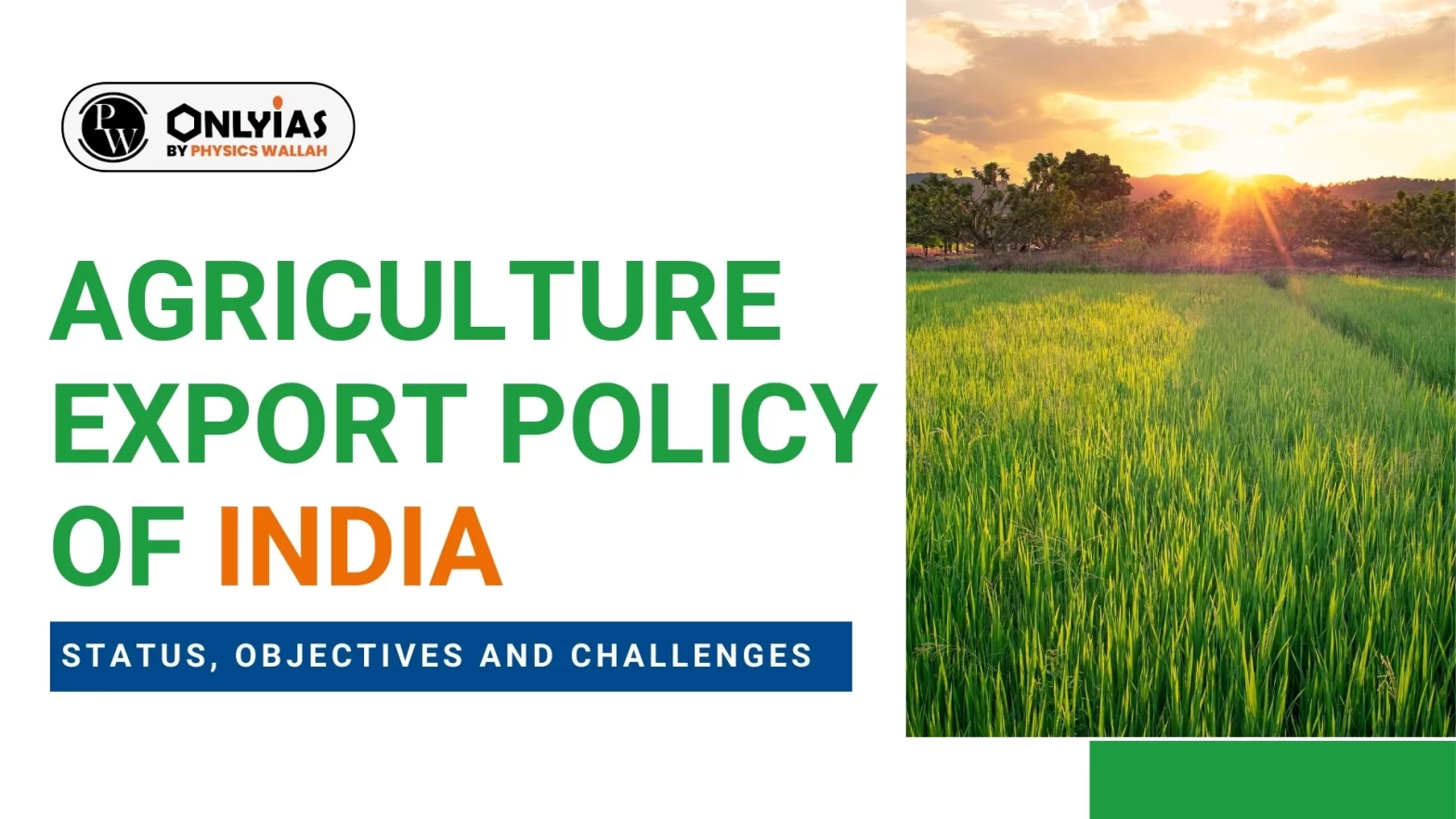Context:
This article is based on the news “Export potential” which was published in the Business Standard. The Indian government targets to double agricultural exports to around $100 billion by 2030.
Agriculture Export of India: Latest Data
- Current Agriculture Export Value: The value of India’s agriculture exports was $52.50 billion in 2022-23, while in 2021-22 it was $50.21 billion.
- Need for Accelerated Growth: Thus, the growth will need to be accelerated significantly in order to attain the target of $100 billion, which will help push agricultural growth in the country and raise farmers’ incomes.
Status of Agriculture Export and Import from India
- Share in Global Production and Exports: India ranks second in global agriculture production, but its share in global agricultural exports is only 2.4 percent, placing it eighth in the world (WTO’s Trade Statistical Review, 2022).
- In 2023, India exported 44 MMT and imported 25 MMT of agriculture products.
- Share in GDP: In terms of domestic contributions, agricultural exports make up less than 2 percent of India’s GDP, which is lower compared to other developing agrarian countries.
- Top Agriculture Imports: Vegetable oil, pulses, and fresh and dry fruits account for 72.1% of agriculture imports of India in 2023.

-
- Vegetable oil is the largest import constituent, accounting for 51.9% of the total agriculture imports of India.
- Top Agricultural Exports from India: Basmati rice, non-basmati rice, sugar, spices, and oil meals – account for 51.5 percent of India’s total agriculture exports.
Agriculture Export Policy in India:
- It is framed with a focus on agriculture export-oriented production, export promotion, better farmer realization, and synchronization within policies and programmes of the Government of India.
Agriculture Export Policy, 2018:
- It is the most recent agricultural policy of India aimed at doubling agricultural exports and integrating Indian farmers and agricultural products with the global value chains.
- Objectives of the Agriculture Export Policy:
 To double agriculture exports by 2022 and reach US$ 100 Billion in the next few years with a stable trade policy regime.
To double agriculture exports by 2022 and reach US$ 100 Billion in the next few years with a stable trade policy regime.- To diversify the export basket, and destinations and boost high-value and value-added agricultural exports including a focus on perishables.
- To promote novel, indigenous, organic, ethnic, Traditional, and Non-traditional Agri products exports.
- To provide an institutional mechanism for pursuing market access, tackling barriers and dealing with sanitary and phyto-sanitary issues.
- To strive to double India’s share in world agri exports by integrating with the global value chain at the earliest.
- Enable farmers to benefit from export opportunities in overseas markets.

What Are the Factors Affecting Indian Exports?
- Expiry of Nairobi Package: The 10th Ministerial Conference (MC) at the World Trade Organisation (WTO) in 2015 in Nairobi provided India a sunset clause for developing countries and LDCs to phase out export subsidies provided by them for their agriculture exports.
- Thus, India is bound to put an end to its export subsidies by the end of 2023.
| Public stockholding (PSH) is a policy tool used by governments to procure, stockpile and distribute food when needed. Ex: MSP scheme.
Agricultural and Processed Food Products Export Development Authority (APEDA): It is a statutory body under the Ministry of Commerce and Industry responsible for promoting export of agricultural and processed food products from India. |
-
- India’s large public stockholding for food security is a contentious issue and the US dragged India to the WTO, challenging Indian export subsidy programs as trade distorting and WTO non-compliant.
- Limited Agri-Export Basket: According to the Global Trade Research Initiative (GTRI), India’s agri-export basket is dependent on just five commodities making the sector vulnerable to fluctuations in global prices and demand.
- These five products – Basmati Rice, Non-basmati Rice, Sugar, Spices, and Oil Meals– account for 51.5 percent of India’s total agriculture exports.
Restrictive Trade Policy of India
- Ban on Wheat and rice: In May 2022, the government banned exports of wheat, and broken rice in September 2022, and levied a 20% duty on all white (non-parboiled) non-basmati grain shipments.
- In August 2023, a 20% duty was levied on exports of parboiled non-basmati rice, while basmati shipments were subjected to minimum export price (MEP) curbs.
- Ban on Sugar Export: Besides wheat and rice, the government, in May 2022, moved sugar exports from the “free” to “restricted” category and capped the total quantity of the sweetener that could go out during any year.
|
- India’s Uncertain Trade Policies: India has banned exports of those products in which it has held a leadership position in the world market for several years.
- For example, India imposed a ban on the export of rice which contributes to over 40 percent of worldwide rice exports.
- Imposing restrictions not only affects global food security, particularly for less affluent nations in the Global South but also undermines India’s reputation as a dependable food supplier.
- Infrastructural Issues: The sector is hindered by inadequate cold chain infrastructure (CCI) and inefficient logistics and there is little awareness of the need for farmgate packhouses (pre-cooling units with cold rooms) or other CCI components.
-
- This leads to spoilage and export competitiveness issues, including problems related to the quality of products.
- According to the APEDA, approximately 40% of the country’s food is spoiled due to this impacts the farmer’s income.
- Small and Fragmented Landholdings: Small and marginal landholdings, coupled with a lack of access to credit present challenges in transitioning to commercial production.
- Small and marginal farmers with less than two hectares of land account for 86.2% of all farmers in India.
- Geopolitical Conflicts: India’s agricultural exports have faced the logistical challenges arising from the Red Sea crisis which resulted in high freight rates and container shortages.
- About 15 percent of global shipping traffic transits through the Suez Canal, the shortest shipping route between Europe and Asia, connecting the Red Sea and the Mediterranean.
- Iran-aligned Yemen Houthi militant group recently launched a drone attack on a cargo vessel in response to Israel’s assault on the Gaza Strip.
- India’s exports to Europe through the Suez Canal (in the Red Sea) include food products, apparel, and electronics, among others, and its imports include crude oil.
Must Read: State Of Food And Agriculture Report 202
Government Initiatives to Boost Agriculture Exports
- India’s Agriculture Export Policy: It calls for overhauling infrastructure and logistics, greater involvement of state governments, and developing export-centric clusters to ensure surplus produce that meets standard quality parameters.
- Agri-Cells: Agri-cells in Indian embassies across 13 countries have also been set up to provide inputs on a real time basis to improve Indian exports at these destinations.
- Ex- Vietnam, USA, Bangladesh, Nepal, UAE, Iran, Saudi Arabia, Malaysia, Indonesia, Singapore, China, Japan and Argentina.
- Free Trade Agreements (FTAs): India has signed FTAs with various countries in an effort to remove trade barriers.
- Export-oriented agricultural produce processing and storage facility: State-owned Jawaharlal Nehru Port Authority (JNPA) plans to build it in Maharashtra.
- The proposed facility aims to enhance processing efficiency, reduce multiple handling, and address infrastructure deficiencies, thereby curbing avoidable wastage in export and import.
- GI Tag to Agri-Food Items: 158 food and agri Geographical Indications (GIs) and the identification of 708 unique food items across districts under the One District One Product (ODOP) initiative.
- Sea Protocols for Agricultural Exports: India is developing sea protocols for various fresh fruits and vegetables like bananas, mangoes, pomegranates and jackfruit to promote their exports through ocean routes.
- The protocol includes understanding voyage time, scientifically understanding the ripening of these commodities, their harvest time, and the training of farmers.
- Other Schemes include:
- The Remission of Duties and Taxes on Exported Products (RoDTEP scheme),
- The Advance Authorisation Scheme
- The Duty Drawback Scheme (DBK scheme)
Also Refer: Centre Approves Minimum Support Prices for Rabi Crops 2024-25
Reforms Needed to Push Indian Exports
- Diversification of Food Export Basket: India needs to increase diversification in its food export basket to contain the risk to overall exports with a decline in the production of one item or the other.
- For this, India should give a boost to exports of value-added millet products. Higher diversification will help India insulate itself from fluctuations in global prices and demand.
- Focusing on Increasing Productivity: Competitiveness results primarily from increasing productivity requires massive investments in agriculture R&D, seeds, irrigation, fertilizers, better farming practices including precision agriculture.
- India’s overall investment in agriculture R&D is around 0.5% of the agri-GDP which is meagre and needs to be immediately doubled.
- Despite having the highest area under rice cultivation, significantly more than China, India is the second-largest producer due to its lower yield rates, standing at 2,809 kg/hectare in contrast to 6710 kg per hectare of China.
- Developing Robust Export Infrastructure: To increase agricultural exports, there is an urgent need for the development of high-quality infrastructure at seaports and airports, which serve as the main exit points for imports and exports.
- Attracting private investment in processing and related activities will help boost exports.
- Focusing on ready-to-eat foods: India’s focus should be on the export of large-scale food processing rather than exporting only raw materials.
- This includes segments like “ready-to-eat” foods.
- Brand India through Strong Marketing and Promotion: In this regard, the government should allocate separate funds for campaigns, exhibitions, digital campaigning, and promotion strategies for Indian products both at the domestic and international levels.
- Trade and industry associations and Indian missions abroad can also play a prominent role in this.
- Balancing Export Earnings with Environmental Costs: Rethinking on the agricultural export policy is needed as India’s export basket is based on water-intensive crops and export earnings do not justify environmental costs in most cases.
- Ex-China, which has higher rice productivity than India does not encourage the export of rice as every kg of rice product can consume up to 80 litres of water.
- Removing Trade Barriers: A task force needs to be established within the Commerce Ministry to identify and eliminate trade barriers.
To get PDF version, Please click on "Print PDF" button.


 To double agriculture exports by 2022 and reach US$ 100 Billion in the next few years with a stable trade policy regime.
To double agriculture exports by 2022 and reach US$ 100 Billion in the next few years with a stable trade policy regime.
